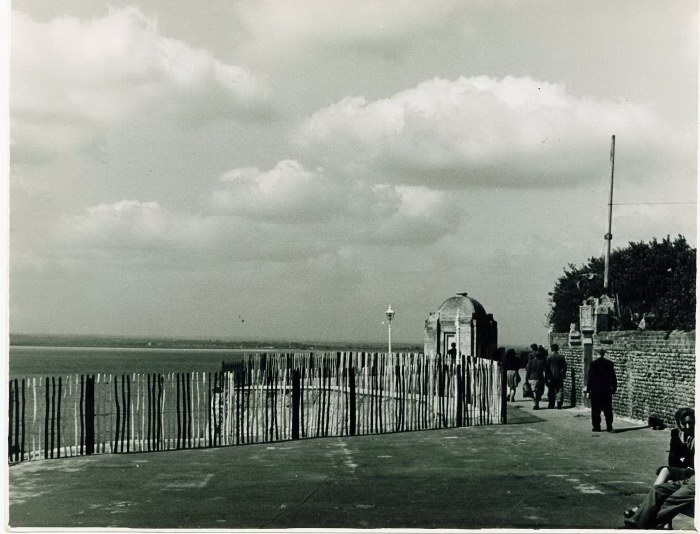St. Augustine's Caves

The Grange, on the Westcliff of Ramsgate
.
These extensive caverns were supposed to have been used in both World Wars as civilian Air Raid shelters and apparently could hold many thousands of people. The system even included an underground ballroom!!
They are shown on a plan of the Ramsgate WW2 Air Raid tunnel system, marked as 'Existing Caves':

During the second world war a public entrance was dug into this tunnel system from the public recreation ground opposite, which has long since been sealed up. The outline of it can still be seen in the grass during the summer months. The only remaining access into this underground tunnel system is from beneath the Grange itself.
Access to the cliff entrances were sealed up in the late forties, during the cliff defences construction work which has now obscured most of them, although some blocked entrances to this system can still be seen along the cliff face today
 A rare photo of St. Augustines caves, c.1948, before the cliff defences were constructed
A rare photo of St. Augustines caves, c.1948, before the cliff defences were constructed
For many years, we have tried to find a way into this old system, and find the rumoured underground ballroom, until recently I came across some photos showing that in 1947 that whole section of cliff collapsed in on itself, destroying a large part of these underground caves! The ball-room, along with many of the other tunnels, were exposed clearly in these photos, as shown below.
It seems perhaps Pugin built one tunnel too many! I suspect that the area was weakened considerably by these unsupported caverns and catacombs, and then due to sustained bombing in WW2 and particularly harsh weather conditions finally caused the major collapse that you see here...
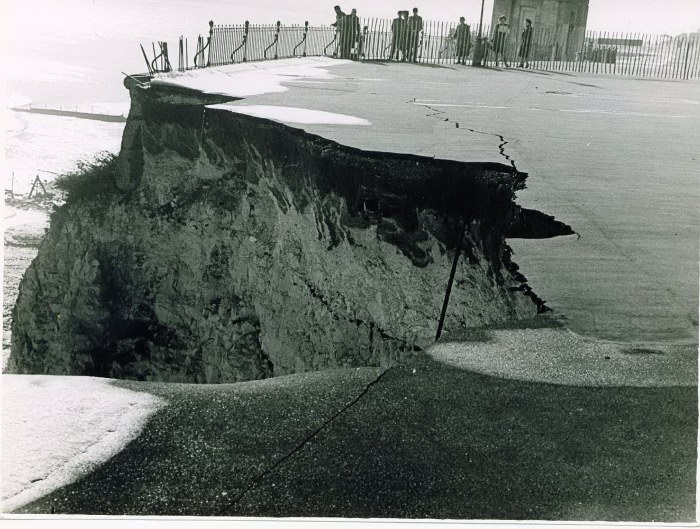
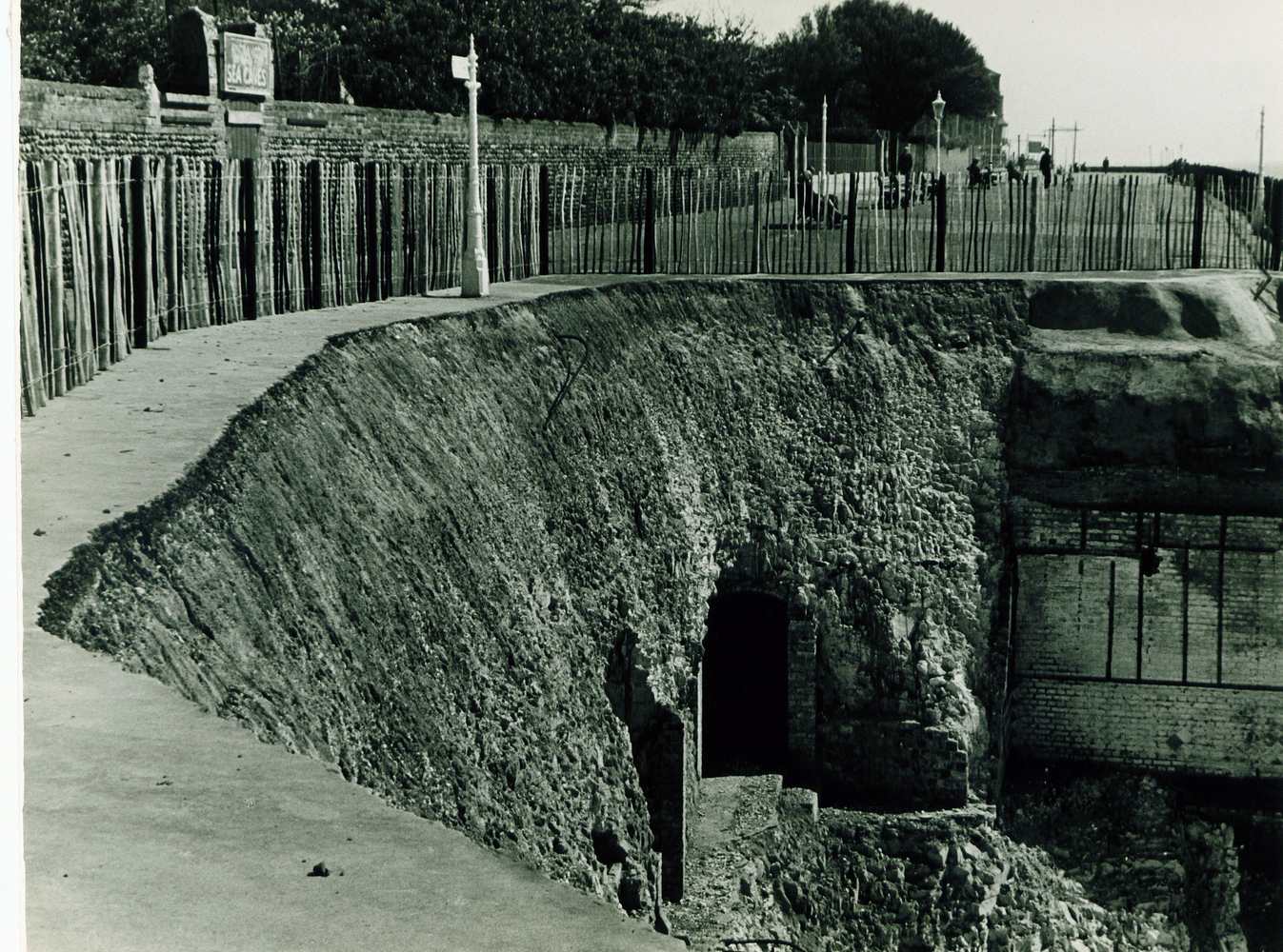 In this exposed cavern, you can clearly see the brick wall (below right) of what appears to be a large underground room. I suspect this was the ball-room, which likely had a balcony on the cliff face, overlooking the sea
In this exposed cavern, you can clearly see the brick wall (below right) of what appears to be a large underground room. I suspect this was the ball-room, which likely had a balcony on the cliff face, overlooking the sea
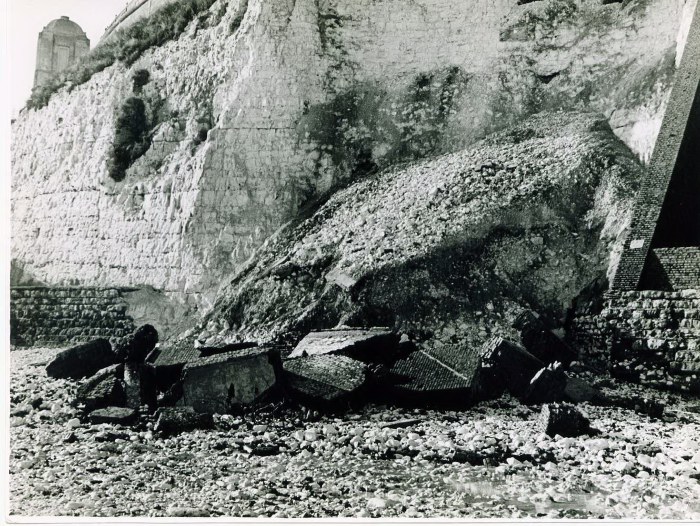 I hope nobody was standing underneath that lot when it fell!
I hope nobody was standing underneath that lot when it fell!
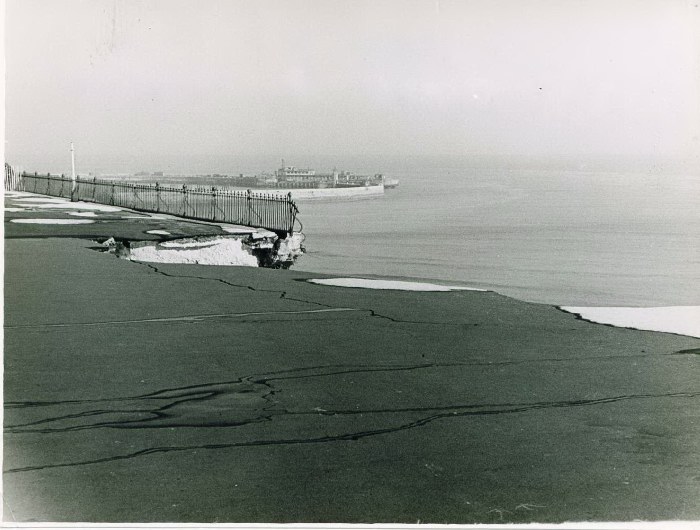
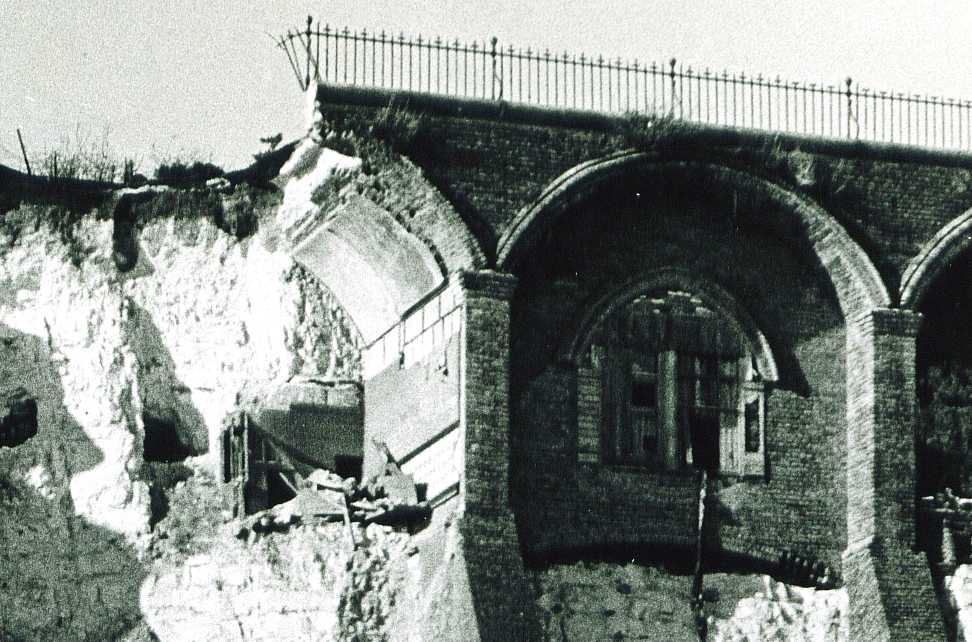 Here you can clearly see an underground room (still intact) to the right, which opened onto the cliff face. The room on the left has been destroyed by the collapse, but several tunnels can still be seen entering the cliff from the rear of (what was) a large room. These tunnels likely connected with the other caverns, and up to the Grange
Here you can clearly see an underground room (still intact) to the right, which opened onto the cliff face. The room on the left has been destroyed by the collapse, but several tunnels can still be seen entering the cliff from the rear of (what was) a large room. These tunnels likely connected with the other caverns, and up to the Grange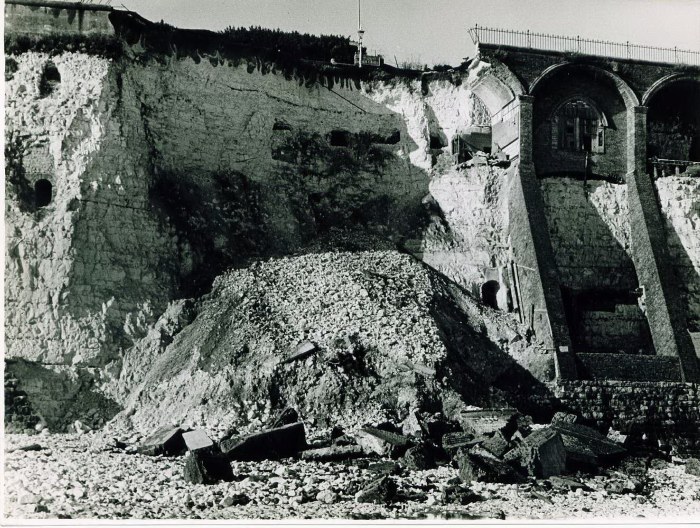 Another view of the collapse, showing the exposed caverns behind it
Another view of the collapse, showing the exposed caverns behind it
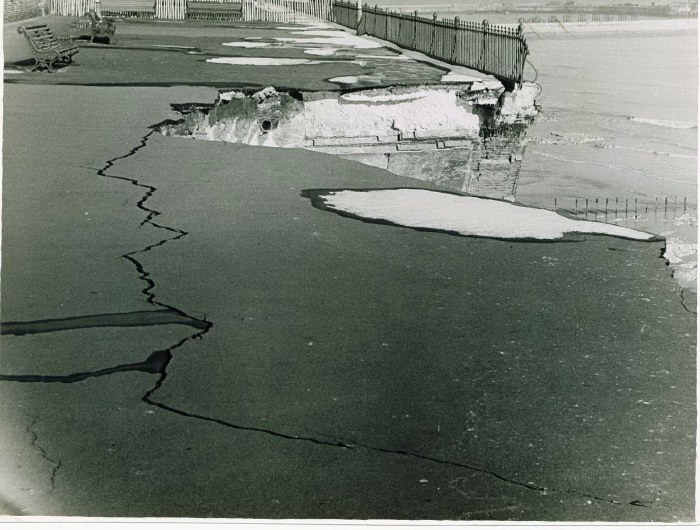 A large chunk has been taken out of the cliff during the collapse. The exposed brickwork beneath the surface shows just how close to the surface some of these underground rooms were. The large crack in the ground looks scary!
A large chunk has been taken out of the cliff during the collapse. The exposed brickwork beneath the surface shows just how close to the surface some of these underground rooms were. The large crack in the ground looks scary!
Many Thanks to Michael's Bookshop where these images have been borrowed from.
Since this collapse, significant reinforcement work has occurred to the Westcliff, with large concrete arches being constructed to strengthen them. These completely obscure what's left of these underground caves today, except for some blocked entrances still visible at ground level, and even a couple of open entrances tantalisingly out of reach, high up in the cliff.

 A close up of another blocked entrance
A close up of another blocked entrance
 One of the open entrances, higher up the cliff face. It was originally blocked by a brick wall about 6 feet inside the tunnel, which has been broken through. Would make for an interesting abseil!
One of the open entrances, higher up the cliff face. It was originally blocked by a brick wall about 6 feet inside the tunnel, which has been broken through. Would make for an interesting abseil!
Epilogue:
In 2003, the Kent Underground Research Group were invited to the Grange (during it's restoration) to investigate a tunnel that had recently been uncovered in the basement, beneath a large trapdoor. I was fortunate enough to be part of that team.
A long flight of narrow wooden steps lead down into a high, narrow chalk tunnel, with an arched ceiling, carved out of the chalk. The ceiling was supported by old wooden beams.
The tunnel twisted and turned quite a bit, and after about 200 metres, came to an end. There was a blockage straight ahead, likely caused by a roof fall, preventing us going any further. Also to our right was a brick wall. Due to the salty smell in the air, and the sound of seagulls beyond this wall, we suspected it lead out to the cliff face, and was one of the blocked exits. Sadly the collapse ahead of us prevented any further exploration of this fascinating man-made cave system. This access tunnel was likely built by Pugin as the original entrance into this cave system that he had constructed.

Diagram of the cliff face as it appears now, with two of the higher up entrances shown, which are still visible today, and thought to be accessible
-
The Pugin Tunnel
The following personal account was written by the daughter of a groundsman who worked at the Grange many years ago, and is published in the Ramsgate Millenium Book, relating to the tunnel beneath The Grange:
"In the 1930's, Paddy O'Brien used to dress as a pirate and take people into the tunnel which ran from The Grange to the foreshore below. There was a gate in the wall. People would go through this, and just inside the garden was an entrance to the tunnel.
They went down a few steps and were in the tunnel. Mr. O'Brien would take them up towards the house and down to the bottom. There was an entrance inside The Grange which was not used by the public but which I've used - you pulled back a tapestry which kept out the draught by the kitchen in The Grange.
It was only a tunnel. There were no "rooms" down there. There were two or three 'run-offs' - short tunnels - which you could stand in. There was no light in there. You had to take a lantern.
The tunnel opened onto the foreshore, near the lift entrance. Protecting the opening was an iron grating. Father used to go down there regularly. He said that Pugin used to tie a dinghy to the gate. Pugin used it to row out to his boat in the harbour. Presumably Mr. O'Brien was at the top entrance all day during the summer, taking visitors down for a few pence each. He worked for the Abbey which owned The Grange and was odd job man for them.
In those days the monks were not allowed out of the Abbey except on business or religious duties. You wouldn't even see them coming out of the door to cross the road to the church - they would use the tunnel. I don't know how true this is, but I was told that the tunnel was constructed to save the monks from being run over by the trams coming round the corner from Grange Road.
The tunnel was exposed after the cliff had collapsed. During the War, the big guns were located there. When they fired them, the pavement cracked. No repairs were done. Moisture and frost got in, and after the War the cliff collapsed. They filled in the gap with concrete and sealed off the entrance to the tunnel."
So it seems there is only firm evidence of a single tunnel, running beneath the Grange to the foreshore beneath the cliffs, with a few short off-shoots. The elusive 'cave network' , with its many cliff face entrances (as shown in the 1940's photograph above) remains a mystery!
Labels: caverns, caves, st. augustine, westcliff
